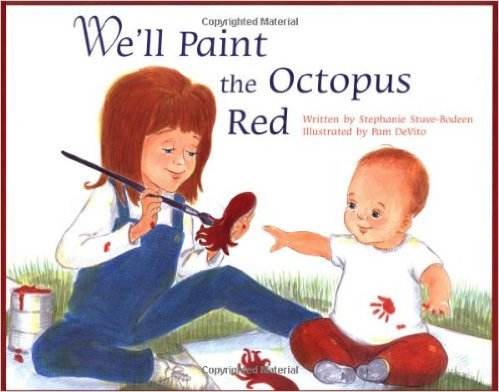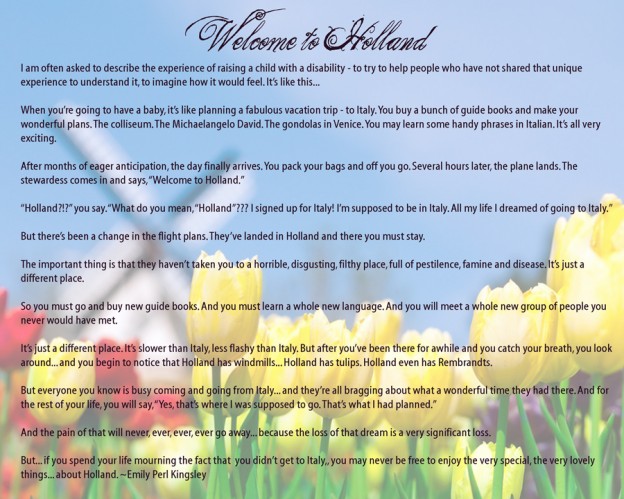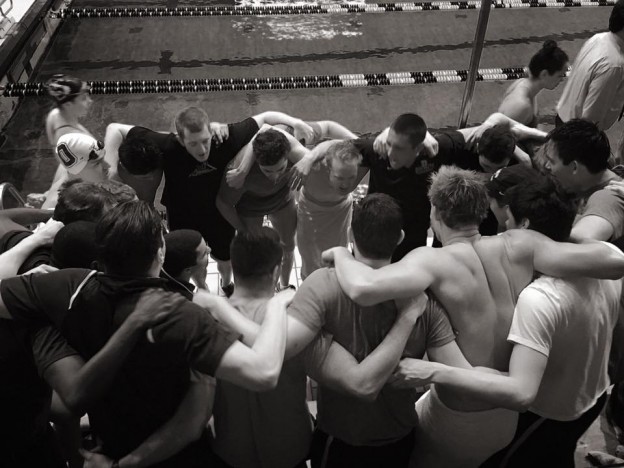- Title: Leaving 5 Seconds Behind
- Informant: Sierra Levene, 19, Female.Sierra grew up in Wyoming and currently attends Dartmouth College where she is a freshman. She just began swimming competitively on the Dartmouth College Club swim team this year. When interviewed, Sierra discussed various aspects of swimming that were difficult to understand when she first joined the swim team. This included etiquette and proper behavior at swim meets, as well as phrases and expressions that make up a unique “language of swimming.”
- Customary: Etiquette
- Language: English
- Country of Origin: United States
- Social / Cultural Context: In practice, swimmers will leave 5 seconds behind the swimmer in front of them. This is not an estimation- since training in swimming is interval based, it is important to leave 5 seconds to maintain your own set of intervals.
- https://youtu.be/jWiiOgTcjk4
(Audio Only)
- Transcript: Definitely leaving 5 seconds”
- Informant’s comments: Sierra emphasized the importance of leaving 5 seconds behind a person so that you do not swim right behind them “on their feet” and annoy them
- Collector’s comments: 5 seconds seemed to be the universal magic number for how long you should wait before going after the person in front of you.
- Tags/Keywords: Etiquette, 5 Seconds
Monthly Archives: May 2016
Relationship Rhymes
Title: Rhymes (Verbal Folklore Category)
Informant Information: Anonymous female member of the Class of 2017 from Houston, Texas. She is also a member of Alpha Phi sorority.
Type of Folklore: Verbal Folklore Rhymes
Language: English
Country of Origin: United States of America
Social / Cultural Context: The games and the traditions engrained in Dartmouth culture also come along with rhymes and sayings that go along these activities. Most informants discussed how an invitation to play pong is the best pick up line at Dartmouth. In addition, one informant revealed a rhyme used by the sailing team to further discourage teamcest.
Associated File:
Transcript:
(Anonymous 1)“You want to play pong?”
“That’s the go to when trying to pick up a guy or a girl?”
“Yeah that’s the go to.”
(Anonymous 2) “Don’t unzipper the skipper.”
Collector’s Comments: One of our informants described another pick-up line being “You want to play pong?” Another female alerted us to the sailing rhyme about teamcest described above. These are all examples of the verbal folklore that has arisen from Dartmouth’s various games and traditions surrounding its relationship culture.

Music as Communication in the Classroom: “What’s the Weather?”
“What’s the Weather?”
Informant information:
Lauren Grant is a 20 year old woman from Andover Massachusetts. She attends school at Quinnipiac University in an occupational therapy program. She has worked at the Recreational Education Center in Peabody, Massachusetts, an after school and summer care program for children with special needs, for the past four years. She has sent some examples of songs that the teachers use to engage with the students during “circle time”, a special period of peer-oriented activity in the course of their day.
Type of lore: Verbal
Language: English
Country of Origin: United States of America
Social / Cultural Context:
At the Recreational Education Center in Massachusetts, an after-school and summer care program for children with special needs, the following songs are sung by teachers of children with special needs in order to engage with the students. The students sing these songs along with the teachers. They are sung during “circle time”, which is an activity in which the the entire day center joins together, and all of the kids and teachers do an activity together instead of working one-on-one. It is a period for learning and socializing.
Transcript:
What’s the weather,
What’s the weather,
What’s the weather like today?
Is it sunny, is it cloudy?
What’s the weather like today?
Informant’s comments:
This song is sung to the tune of “Oh my Darling Clementine”.
After the song is performed, “one of the children is picked to describe the weather. They are given choices of hot, cold, sunny, cloudy, rainy, windy or snowing. They point to or pick up signs and leave them on the board for the rest of the day.”
Collector’s comments:
This folklore is important to children with special needs because of the way it teaches them about the weather and helps them to communicate. It has a clear purpose, which is to help the children learn another complex topic that is difficult for them to comprehend. This song is authorless, taught to the children by their teachers, and uses a lot of repetition, participation and images to keep the children engaged.
Tags/Keywords: Song, Children, Special needs

Music as Communication in the Classroom: The Beginning and Conclusion of “Circle Time”
The Beginning and Conclusion of “Circle Time”
Informant information:
Lauren Grant is a 20 year old woman from Andover Massachusetts. She attends school at Quinnipiac University in an occupational therapy program. She has worked at the Recreational Education Center, an after school and summer care program for children with special needs, for the past four years. She has sent some examples of songs that the teachers use to engage with the students during “circle time”.
Type of lore: Verbal
Language: English
Country of Origin: United States of America
Social / Cultural Context:
- At the Recreational Education Center in Peabody, Massachusetts, an after-school and summer care program for children with special needs, the following songs are sung by teachers of children with special needs in order to engage with the students. The students sing these songs along with the teachers. They are sung during “circle time”, which is an activity in which the the entire day center joins together, and all of the kids and teachers do an activity together instead of working one-on-one. It is a period for learning and socializing.
“The Introduction Song”
https://youtu.be/XgyjdMQuUkU
Transcript:
“An Introduction Song”
It’s very nice to meet you,
Have a great, great day!
It’s very nice to meet you,
And this is what we say!
Shake my hand, shake my hand, shake my hand!
“Circle time is over”
Circle time is over now, over now, over now!
Circle time is over now,
It’s time for <insert next activity>
Informant’s comments:
Lauren stated that the first song is used as an “introduction song”
The second is sung at the end of circle time, to the tune of London Bridge is Falling Down. This song is used primarily as a transition into the next activity, which can be snack time, free-play, individual learning, etc.
Collector’s comments:
We categorized these pieces of folklore under verbal lore because they are sung. This folklore fits under the category of folklore from families with children with special needs because the children with special needs sing these songs along with their teachers. These songs are also authorless. They contain repetition and rhyme for easy memorization. These songs are specific to this center for children with special needs because of how they’re used on a daily basis. Transitions are often difficult for children with special needs to navigate, and the employment of these simple, repetitive songs at the beginning and conclusion of every “circle time” serves to signal to the children when they can expect a change.
Tags/Keywords: Song, Music, Special needs,

Music as Communication within Families
Music as Communication within Families
Informant information:
Mary Kate resides in Andover, Massachusetts. She has a daughter who has an undiagnosed developmental disorder. Her daughter is nine years old and participates in the” My Own Voice” choir, a choir for children with special needs in Andover.
Type of lore: Customary
Language: English
Country of Origin: United States of America
Social / Cultural Context:
Mary Kate and her husband Neal often sing to their daughter as a way to communicate with her. Other people in their daughter’s life use this technique as well, since her developmental disorder makes it more difficult for her to communicate using spoken language.
This use of music as a form of communication was something we found to be consistent across many families with children who have special needs.
https://www.youtube.com/watch?v=RlCCiTASNoc
Informant’s comments:
Music has always been used by many people in [our daughter’s] life to communicate and interact with her. As you do with all babies, Neal and I sang to [her] as we cuddled and held her close to sooth and help her sleep. [Her] grandmothers also did the same thing when holding her close. What is unique with [our daughter] is that even though she is almost 10 years old we still do the same thing.
[She] often times still drifts off to sleep with the “soothing ” tones of me or Neal (and trust me we cannot sing) in her ear. The songs vary based on her mood and how long we are singing. Neal and I both sing songs that we heard from our parent. We sing songs from movies and musicals right now Mary Poppins is a preferred choice. We make up songs to melodies that she knows and use current information to keep her engaged such as what happened that day or what is happening in the future. I even sing commercial ditties the oscar mayer wiener song is popular as is the oscar mayer bologna song.
Songs can be used as a reward as well. [She] has a token board at school and if she complies with the rules and expectations she receives positive marks throughout the day. If she receives enough checks she earns the opportunity to pick something from the treasure chest. When she gets in the car at parent pick up, if she has a good day (earned treasure chest) I sing this song… I’m proud of you. I’m proud of you. I hope that you are proud of you too! [Our daughter] loves this and beams while I am singing. Honestly, 99% of the tangible rewards from the treasure chest are forgotten and returned to school. She really is motivated by the song.
Collector’s comments:
We found this behavior of communicating through song to be a piece of customary folklore because it was something we saw consistently used across multiple families with children with special needs.
Because of the unique nature of certain developmental disorders, we saw the use of music to be an effective mode of communication between parents and their atypical children. This mode of communication is customary because of the way that parents of children with special needs share this technique with each other.
Tags/Keywords: Music, Communication, Custom, Special needs, family

When You Thought I Wasn’t Looking
When You Thought I Wasn’t Looking
Informant information:
Mike and Sue have a daughter who has autism. She is twenty years old and participates in the “My Own Voice” choir, a choir for children with special needs in Andover, Massachusetts.
Type of lore: Customary
Genre: Tradition
Language: English
Country of Origin: United States of America
Social / Cultural Context: This poem is passed on to new members of the special needs community – these new members are family members of children who have been recently diagnosed. It is unique in it’s own way because it is meant to give the family a sense of what their child is feeling, because ascertaining that from a child who cannot speak is very difficult.
Poem:
“When You Thought I Wasn’t Looking”
When you thought I wasn’t looking, you hung my first painting on the refrigerator and I wanted to paint another.
When you thought I wasn’t looking, you fed a stray cat and I thought it was good to be kind to animals.
When you thought I wasn’t looking, you baked a birthday cake just for me and I knew that little things were special things.
When you thought I wasn’t looking, you kissed me at night and I felt loved.
When you thought I wasn’t looking, I saw tears come from your eyes, and I learned that sometimes we can cry.
When you thought I wasn’t looking, you smiled and it made me want to look that pretty too.
When you thought I wasn’t looking, you cared and I wanted to be everything I could be.
When you thought I wasn’t looking, I looked and I wanted to say thanks for all those things you did when you thought I wasn’t looking.
–Your special child
Informant’s comments:

Explaining Through Stories
Explaining Through Stories
Informant information:
Pam is from Andover, Massachusetts. She has a seven-year-old daughter with Down Syndrome who participates in the “My Own Voice” choir, a choir for children with special needs in Andover.
Type of lore: Customary
Language: English
Country of Origin: United States of America
Social / Cultural Context: This book is shared among parents of children with special needs when trying to decide how to explain a new baby’s special needs to their typical siblings. Therefore it is most often used when the family is first entering the special needs community.
Informant’s comments
Another book, I thought was very helpful in explaining Down Syndrome to my other kids was… “We’ll Paint the Octopus Red” by Stephanie Stuve-Bodeen
It is a story about how a family is expecting a baby, and the older sister is all excited to do all these fun things with the new baby ( go to the beach, visit grandma, sing, paint, dance, love, play kickball etc). But after the baby is born the parents are crying. The little girl asks what is wrong? The Dad explains that the baby, little Isaac has Down syndrome. the girl says, ooh.. So does that mean the baby can’t play kickball with me? The dad says, it might take the baby a little longer to learn how to walk, but he could learn to play kickball. The little girl says, so baby Isaac won’t be able to ride in the minivan and eat fruit snacks with me, and the dad says I think he’ll be able to do that too.. Well then he won’t be able to go visit grandma and have sleepovers with me, and the dad says I think he would love to do that… So the little girl says, so if Isaac has this down thing then what can’t he do? And the dad says there actually probably isn’t anything that he can’t do.
We found the book helpful. And then it was a good conversation starter about what is Down syndrome… we explained it to our kids, how everyone when they are born are given a set of chromosomes, one set from your mom and one from your dad. And how these chromosomes are the directions that your body follows on everything, how to breathe, grow, the color of your eyes, if you will be a good singer etc.. And when [our daughter] was born she got one more chromosome then the rest of us… So she has more sets of directions to follow then us, and that is why it takes her longer to learn how to walk and talk and sing…
Collector’s comments:
The informant stated that the title of the book was “Let’s Paint the Octopus Red” but the title is actually “We’ll Paint the Octopus Red”
The book itself is not folklore since it has an author, and folklore is authorless by definition. However, we found that the shared behavior of using this book to explain Down Syndrome to children was a tradition shared between parents of children with special needs.
Tags/Keywords: special needs, Tradition, Down Syndrome, Folklore, Book, Story

The Holland Poem
The Holland Poem
Informant information:
We received the same submission from 2 sources; both are listed below.
Pam has a daughter who has Down Syndrome. She is seven years old and participates in the “My Own Voice” choir, a choir for children with special needs in Andover, Massachusetts.
Diane has a son who also has Down Syndrome. He is twenty-five years old, and has been a member of the “My Own Voice” choir for several years now, and still participates. “My Own Voice” is a choir for children with special needs in Andover, Massachusetts.
Type of lore: Customary
Genre: Tradition
Language: English
Country of Origin: United States of America
Social / Cultural Context: This poem is passed on to new members of the special needs community by friends, families and even doctors. These new members are family members of children who have been recently diagnosed with various forms of special needs.
The Holland Poem:
“Welcome To Holland”
by Emily Perl Kingsley. c1987 by Emily Perl Kingsley. All rights reserved
I am often asked to describe the experience of raising a child with a disability – to try to help people who have not shared that unique experience to understand it, to imagine how it would feel. It’s like this……
When you’re going to have a baby, it’s like planning a fabulous vacation trip – to Italy. You buy a bunch of guide books and make your wonderful plans. The Coliseum. The Michelangelo David. The gondolas in Venice. You may learn some handy phrases in Italian. It’s all very exciting.
After months of eager anticipation, the day finally arrives. You pack your bags and off you go. Several hours later, the plane lands. The stewardess comes in and says, “Welcome to Holland.”
“Holland?!?” you say. “What do you mean Holland?? I signed up for Italy! I’m supposed to be in Italy. All my life I’ve dreamed of going to Italy.”
But there’s been a change in the flight plan. They’ve landed in Holland and there you must stay.
The important thing is that they haven’t taken you to a horrible, disgusting, filthy place, full of pestilence, famine and disease. It’s just a different place.
So you must go out and buy new guide books. And you must learn a whole new language. And you will meet a whole new group of people you would never have met.
It’s just a different place. It’s slower-paced than Italy, less flashy than Italy. But after you’ve been there for a while and you catch your breath, you look around…. and you begin to notice that Holland has windmills….and Holland has tulips. Holland even has Rembrandts.
But everyone you know is busy coming and going from Italy… and they’re all bragging about what a wonderful time they had there. And for the rest of your life, you will say “Yes, that’s where I was supposed to go. That’s what I had planned.”
And the pain of that will never, ever, ever, ever go away… because the loss of that dream is a very very significant loss.
But… if you spend your life mourning the fact that you didn’t get to Italy, you may never be free to enjoy the very special, the very lovely things … about Holland.
Informant’s Comments:
Pam’s Submission:
Hi Angelina,
My name is Pam, I have a 7 year old daughter with Down Syndrome who participates in the “My Own Voice” choir. My husband and I were trying to think of something specific to tell you but I’m not sure how insightful we can be… I figured you already have the Holland poem ( and your mom said you already have it). but I know that poem was very helpful to me, and has allowed me to put a lot of things in perspective.
The holland poem, rings true during all stages of life as well. Not just as a baby, but a toddler on the playground or a high school kid going to the prom. Similar to the holland poem, is the folklore of everyone sitting in a circle and they all throw their problems in the middle, and after seeing and hearing everyone’s issues, you would always want your own problems back…..Folklore being It is not as bad as you think… Maybe a humbling experience.
Not sure if this is helpful or not. I hope you are doing well at school and enjoying it all! Wishing you luck on your presentation.
Kindly,
Pam
Diane’s Submission:
Hi Angelina, What a great assignment, and of course, we would love to help you out. I hope my contribution is relevant and helps … Take care, Diane
The day after [my child] was born, we received a beautiful teddy bear from my aunt with a framed poem inside the gift bag. The name of the poem was “Welcome to Holland” written by Emily Perl Kingsley (see link below). From day one, it had a very profound effect on me. I read it daily for at least the first year of [his] life, and it served as my own personal support message as we learned about his disability, Down syndrome; and subsequently, grew to love and appreciate him more and more each day. We think [he] is funny, cute as a button, mischievous as all get out, totally awesome, and of course, lights up a room like a huge vase of tulips!
Collector’s comments:
While “Welcome to Holland” itself is a literary text because it is a poem with an author, the act of giving this poem to others is folklore – it is a tradition. Moreover, it can also be considered similar to an initiation ritual – the family is being initiated into the special needs community, and the act of giving them this poem is very similar to rites of transition, because they aim at helping this family transition into this new community/phase of their life.
Tags/Keywords: special needs, tradition, customary, poetry

“On My Feet”
- Title: “On My Feet”
- Informant: Anna Kingsbury, Female, 19.Anna grew up in Apple Valley, Minnesota, and was a member of the Eastview High School swim team. She swam on the varsity high school team for four years and was a captain her senior year. When interviewed, Anna discussed her experiences being a swimmer at a high school level.
- Verbal, Phrase
- Language: English
- Country of Origin: United States
- Social / Cultural Context:The term is used by swimmers in practice, at swim meets, and in discussions about swimming
- No audio, transcribed Skype interview.
- Text: “On my feet”
Transcript:“Its seriously the most annoying thing ever. Like when someone is on your feet, meaning they’re swimming so closely behind you that they keep touching your feet. I can’t stand it.” - Informant’s comments: Anna described how this phrase has a negative connotation, since swimming “on someone’s feet” is frowned upon.
- Collector’s comments: This phrase was found commonly among all levels of competitive swimming.
- Tags/Keywords: Phrase, Verbal

College Team Cheer
- Title: Ritual of Team Cheer, College
- Informant #1: AnnClaire MacArt, 20, Female.AnnClaire (AC) was born and raised in Northern California. She currently lives in Hanover, New Hampshire and is a sophomore at Dartmouth College. AC is a member of the Dartmouth College Varsity Swimming and Diving Team. She has swum competitively for over 10 years, including at the age group (club), high school, and now collegiate level.
Informant #2: Andrew North
Andrew North was a four year member of the Dartmouth Men’s Swimming and diving team. In his fourth year on the team he served as one of two captains of the men’s team. He has lived across the US as well as internationally; contributing to his broad knowledge of the national and global swimming communities: his states of residence include Indiana, Texas, Arizona, Tennessee, Nebraska as well as the Philippines. Andrew continued to swim in all of these places, spanning over more than a decade of competitive swimming.
- Customary, Ritual
- Language: English
- Country of Origin: United States
- Social / Cultural Context:This ritual involves a brief team meeting followed by a cheer at a swim meet. These cheers are performed at competitions prior to the start of races. It is not just one team that participates but many; although the actual cheer itself differs for team to team, the ritual of performing a cheer is found as a commonality among all teams. It seems that there is even a recognized time that these cheers be performed; after the first team performs a cheer the other teams’ cheers quickly follow.
- Video: AChttps://youtu.be/uy9uE6zWu0Y
- Transcript: Andrew North:“You know, for me, it was always about the cheer after everyone kindof does their own thing for the pre-meet warm up and their own pre-meet ritual…just feeling the excitement of everyone building up to a big cheer… you do it so that you and your team get pumped up and you literally do, you start screaming and jumping up and down, it would be really hard to walk away from that without getting your heart rate up.”
- Informant’s comments: The team cheer is always done, one of the strongest rituals in swimming.
- Collector’s comments: As both informants were from the same college team, their description of this ritual put together for this piece of folklore.
- Tags/Keywords: Team Cheer

